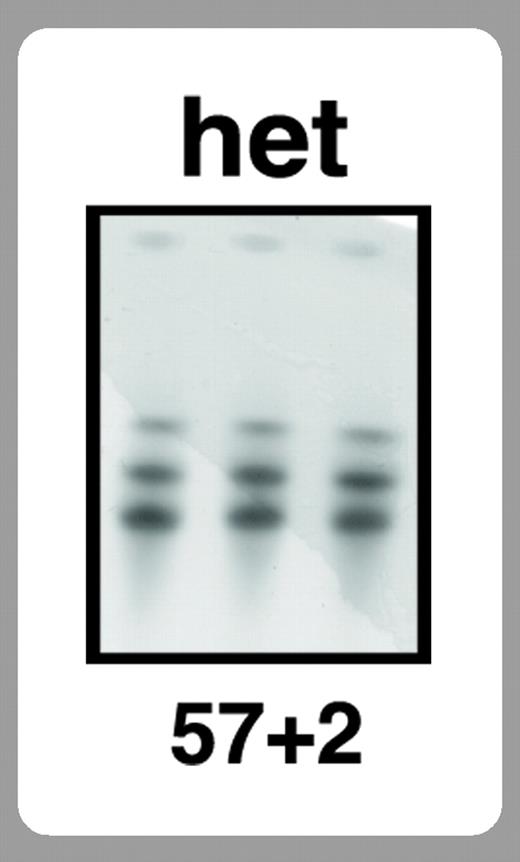HEMATOPOIESIS
The name “stem cell leukemia” (SCL) was assigned to a gene involved in a t(1;14) translocation associated with an acute leukemia with early T-cell phenotype and myeloid differentiation potential. SCL is a transcription factor of the basic helix-loop-helix (bHLH) family and normally functions as a critical regulator of hematopoiesis. It is expressed in hematopoietic stem cells (HSCs) and erythroid and megakaryocytic lineages, but not in granulocyte/monocytes or lymphocytes. It is expressed in endothelium and is critical for hemangioblast development in ontogeny. Forced expression of SCL in zebra fish embryos results in expansion of hematopoietic and endothelial progenitors at the expense of other mesodermal derivatives.1 Enforced expression of SCL in CD34+ cells enhances megakaryocyte and erythroid development and inhibits myelomonocytic differentiation. Mouse embryos lacking SCL die with complete absence of blood.2 Rescue of defective embryos with SCL under a hematopoietic-specific promoter (GATA1) rescues erythropoiesis but embryos still die of defective angiogenesis.2 SCL specifies hemangioblast development from primitive mesoderm in an embryonic stem cell model.3 To overcome in utero lethality, a conditional knockout of SCL in adult mice has been achieved by inducible cre/lox technology.4,5 Mikkola et al4 have reported that adult HSCs retained long-term repopulating activity and multipotency in the absence of SCL. Thus, while SCL is critical for hematopoietic specification, it is not required for HSC self-renewal, or there may exist compensatory systems to sustain SCL-deficient HSCs. Hall et al5 have shown that SCL deletion in adult mice perturbed megakaryopoiesis and erythropoiesis, with loss of early progenitors in both lineages and blunted response to hematopoietic stress. In addition, the spleen colony-forming unit day 12 (CFU-S12), a population of short-term repopulating multipotent stem/progenitor cells, generated only myeloid but not erythroid or megakaryocytic colonies.
In this issue of Blood, Curtis and colleagues (page 3342) used the conditional Cre/Lox system to generate adult SCL null mice and observed a severe defect in the ability of null marrow to provide normal hematopoietic reconstitution by 4 weeks in a transplant model. In competitive repopulation with wild-type marrow, there was a significant reduction in contribution of the SCL null marrow to the myeloid lineage and absence of contribution to the erythroid lineage at 4 weeks. At 16 weeks there was still some defect in contribution to myeloid and lymphoid lineages. How can this be reconciled with the lack of defects in the study by Mikkola et al? Hall et al5 duplicated the Mikkola et al model and, consistent with the latter's report, found no defect with SCL-deleted cells at 4 weeks, although the authors did observe loss of myeloid engraftment at 16 weeks. The explanation for the discrepant results appears to be the capacity of wild-type competitor cells to “rescue” the early transplant defect of SCL-deleted cells. Also in the current issue, Kunisato and colleagues (page 3336) used a retroviral HSC transduction strategy to overexpress SCL or to inhibit it with a dominant-negative (DN) SCL construct. Overexpression of SCL increased short-term contribution to the myeloid lineage, whereas DN-SCL enhanced the contribution to lymphoid lineages without affecting long-term HSC proliferation. This was confirmed using fetal thymic organ cultures where single-sorted DN-SCL cells generated high numbers of T-committed cells and low numbers of myeloid-committed cells. Some effects were seen on erythroid (increased immature cells) but not on megakaryocytic differentiation in animals with DN-SCL that underwent HSC transplantation. The discrepancy between this and most other studies that do not show enhancement of lymphopoiesis could be related to DN-SCL interfering with bHLH motif-containing transcription factors other than SCL. A direct comparison in a competitive repopulation assay of HSC differentiation with SCL knocked down by DN-SCL, or excised by cre/lox, would be informative.


This feature is available to Subscribers Only
Sign In or Create an Account Close Modal